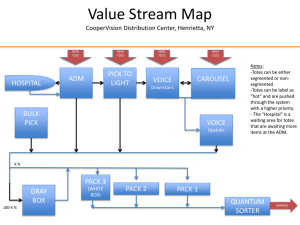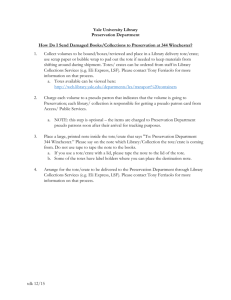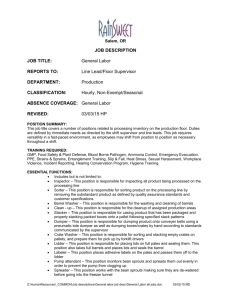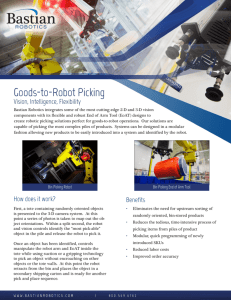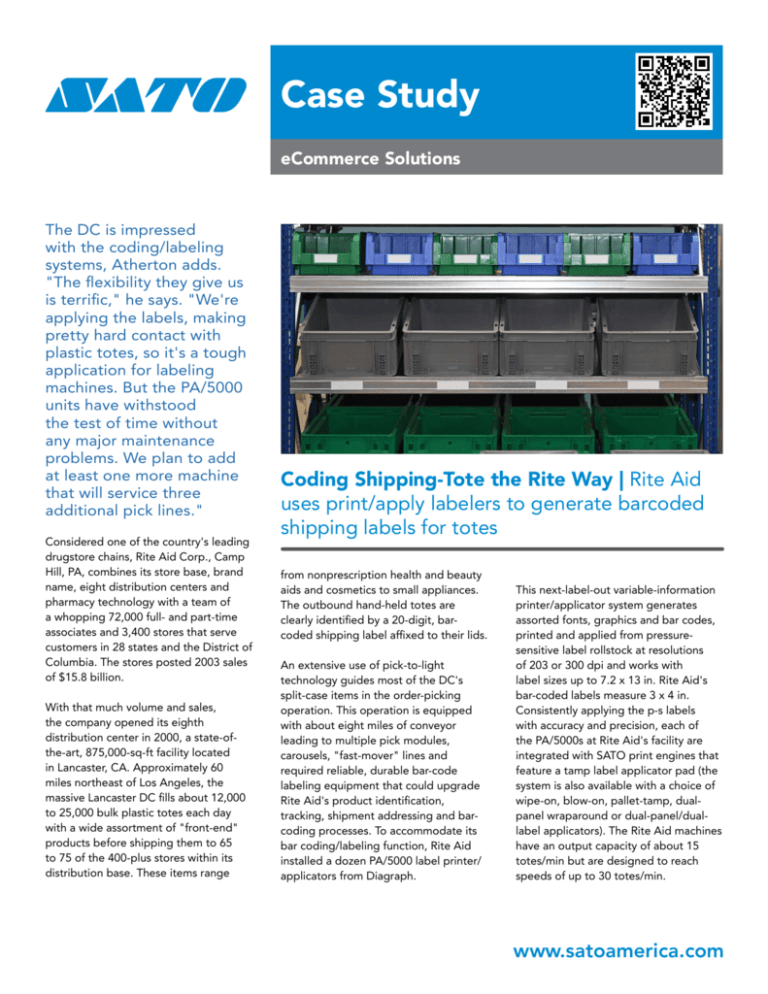
Case Study
eCommerce Solutions
The DC is impressed
with the coding/labeling
systems, Atherton adds.
"The flexibility they give us
is terrific," he says. "We're
applying the labels, making
pretty hard contact with
plastic totes, so it's a tough
application for labeling
machines. But the PA/5000
units have withstood
the test of time without
any major maintenance
problems. We plan to add
at least one more machine
that will service three
additional pick lines."
Considered one of the country's leading
drugstore chains, Rite Aid Corp., Camp
Hill, PA, combines its store base, brand
name, eight distribution centers and
pharmacy technology with a team of
a whopping 72,000 full- and part-time
associates and 3,400 stores that serve
customers in 28 states and the District of
Columbia. The stores posted 2003 sales
of $15.8 billion.
With that much volume and sales,
the company opened its eighth
distribution center in 2000, a state-ofthe-art, 875,000-sq-ft facility located
in Lancaster, CA. Approximately 60
miles northeast of Los Angeles, the
massive Lancaster DC fills about 12,000
to 25,000 bulk plastic totes each day
with a wide assortment of "front-end"
products before shipping them to 65
to 75 of the 400-plus stores within its
distribution base. These items range
Coding Shipping-Tote the Rite Way | Rite Aid
uses print/apply labelers to generate barcoded
shipping labels for totes
from nonprescription health and beauty
aids and cosmetics to small appliances.
The outbound hand-held totes are
clearly identified by a 20-digit, barcoded shipping label affixed to their lids.
An extensive use of pick-to-light
technology guides most of the DC's
split-case items in the order-picking
operation. This operation is equipped
with about eight miles of conveyor
leading to multiple pick modules,
carousels, "fast-mover" lines and
required reliable, durable bar-code
labeling equipment that could upgrade
Rite Aid's product identification,
tracking, shipment addressing and barcoding processes. To accommodate its
bar coding/labeling function, Rite Aid
installed a dozen PA/5000 label printer/
applicators from Diagraph.
This next-label-out variable-information
printer/applicator system generates
assorted fonts, graphics and bar codes,
printed and applied from pressuresensitive label rollstock at resolutions
of 203 or 300 dpi and works with
label sizes up to 7.2 x 13 in. Rite Aid's
bar-coded labels measure 3 x 4 in.
Consistently applying the p-s labels
with accuracy and precision, each of
the PA/5000s at Rite Aid's facility are
integrated with SATO print engines that
feature a tamp label applicator pad (the
system is also available with a choice of
wipe-on, blow-on, pallet-tamp, dualpanel wraparound or dual-panel/duallabel applicators). The Rite Aid machines
have an output capacity of about 15
totes/min but are designed to reach
speeds of up to 30 totes/min.
www.satoamerica.com
CASE STUDY
Rite Aid Generates Barcoded Shipping Labels With Print/Apply
Outfitted with built-in diagnostics and a menu-driven interface, the
PA/5000 is easy to operate, Rite Aid says, with a menu that indicates
all of the machine parameters. The PA/5000's discrete input/outputs
(I/O) were impressive to Rite Aid's Bill Atherton, senior engineer,
supply chain, who spearheaded the equipment installations.
"We needed a print-and-apply system that could deliver highperformance labeling in a demanding industrial environment," he
says. "The I/O capabilities of the Diagraph label printer/applicators
were a big benefit, because they eliminated our having to get
another type of controller just for the labeler. We wanted the
machine to be able to take care of all error inputs and outputs. There
were few label printer/applicators [on the market] that offered this
kind of capability when we purchased these systems. They were
clearly superior."
Atherton says that when all of the mezzanines are taken into account,
there is probably more than a million sq ft of space at the Lancaster
facility. "This is our newest facility, and it's equipped with all new
machinery," he says. "We also installed miles of conveyor from
Siemens Dematic to handle our high volumes at the stores out here."
That the PA/5000 had to be reliable was an understatement,
emphasizes Jack McMahon, regional market director for Diagraph.
"Given the throughput of their operation, it was critical that Rite
Aid have a machine that could run up to seven days a week, twentyfour hours a day," he says. "Reliability was at the top of the page,
along with the ability of the machine to provide enough inputs and
outputs–things we customized for Rite Aid and subsequently built
into our unit as standard features."
The DC is laid out in zones similar to the zones in the company's
stores, which makes restocking the stores more efficient, PD is told.
The DC's sophisticated warehouse-management system (WMS)
includes pick modules for the many stockkeeping units. The picking
operation includes "case-pick" modules from which full caseloads
of products are picked, as well as "each-pick" modules or items
picked from split cases for about 70 percent of the items shipped.
Each module has two or three levels and, according to Atherton,
is a large racking system, with access from two sides–the back for
replenishment and the front for order picking.
On the order-picking side, interactive pick-to-light systems use
lighted numbers under each item on a flow rack to indicate which
items and how many should be picked from each product bay for
each pick list. The picking operator removes the indicated number
of items and pushes a button to confirm the items were picked.
The process is integrated with the label applicators by a personal
computer. Atherton says having label printer/applicators on the
picking lines allows the order pickers to focus solely on filling the
orders without having to carry and affix labels.
Catch A Wave
There are approximately two pick-to-light lines for every label
printer/applicator, Atherton says, which is another reason the
company needed highly dependable coding/labeling equipment.
"The printer/applicators' dependability was absolutely critical," he
says. "It impacts our picking efficiencies because if, for some reason,
a line goes down even for just an hour, our picking efficiency in that
area can drop by up to twenty-five percent, because the totes would
back up on the conveyor line, stuck in the pick module. The machines
have been very reliable, and it's critical for us to have as much uptime
on these machines as possible."
The stores order once a week, which amounts to 40 to 70 truck runs
a day. When a store requests an order, the orders are put into picking
"waves," which designate a set of Rite Aid retail stores. The DC sets
up about six waves per day. When a wave's pick list is released to the
order-picking operation, the pick lists are transmitted to a set of pick
PCs located in the warehouse.
To initiate the picking process, an operator scans their identification
badge using a Symbol hand-held scanner at a specific picking zone
at the pick-to-light system, logs on and scans a permanently affixed,
10-digit identification code/license plate on an empty tote. This
license plate information is then relayed into the PC, which marries
the order pick list to that particular tote. The operator then puts the
tote on a dead-roller conveyor and starts loading the desired number
of items from the perspective rack, which is illuminated below by
pick-to-light numbers on a digital display.
The picking system is complex, notes Atherton, with the barrage of
multilevel mezzanines with conveyors running their length, carousels
for split-case picking on a second-level mezzanine, light-directed
put stations, a set of pick modules, eight cross docks, a bulk storage
area, two pick tunnels and much more.
"There are ten pick lines arranged in four each-pick-from-caseflow
rack modules," Atherton explains. "Two of the modules are two
actual floor levels-high and the other two modules are three-high.
Across from them are two more modules that are each-pick-frompallet-flow lines, which means orders here are split-case-picked
directly from pallets. Each of those modules is three levels-high."
CASE STUDY
Rite Aid Generates Barcoded Shipping Labels With Print/Apply
Picking, Loading, Coding
The facility uses two-way, rugged FP181 high-density polyethylene
shipping totes from Menasha's Orbis Corp., that have two-piece
interlocking lids. Measuring 21 x 14 in., the totes stand 12 in. tall and
have slightly drafted bases.
scanned by a second Accu-Sort system to verify that the correct
information has been printed and the tote exits the labeling area.
Atherton explains, "If there's a software error caused by a bad
scan, for example, the conveyor and labeler will automatically stop
because the scanners are linked to the label applicator PC.
The operator starts to pick a number of the packaged items from
each "lighted" bay, loads the staged tote and then pushes a green
light button to confirm that the items have been picked and loaded
into the tote. Giving these the green light simultaneously updates
the information on the PC.
"The Diagraph labelers have a lot of internal error-checking functions,
which is the main reason we selected them. If, for example, the print
engine is turned off, or if labels aren't feeding properly, the PA/5000
will detect an error and, by means of an output on the machine, send
a message that stops the conveyor. The Diagraph labelers actually
combine our software error signals with their own internal hardware
error signals and will halt the conveyor for either type of problem."
When the tote order is complete, the operator places the filled tote
onto a powered center section of the conveyor to exit the module.
Or, if the system beeps twice, indicating the order isn't complete,
the tote is passed to the next picker in line, in which case, a pick PC
holds the information about what's already been picked and loaded
in the tote and transfers the remaining picking data to the next pick
station.
After an "exit tote" signal is sent to the picker, the completed, filled
tote heads by takeaway conveyor to one of 12 Diagraph PA/5000
print-and-apply labeling systems. The "pick" PC also sends a
message to the PC linked to the label printer/applicator. Stored in a
local database that is called up when the totes arrive, the message
indicates specific data that the PA/5000 will print in the form of a
20-digit bar-coded shipping label.
The shipping label contains a wealth of variable information, such
as the 10-digit tote license plate ID code, which is also printed in
human-readable characters beneath the code itself, plus a five-digit
store code, the picking date, the wave number, the label applicator
ID, a pick-list number and an operator log-on ID for all pickers who
were involved with picking for the tote.
As totes approach the label printer/applicator, they pass a case stop
and a singulation device that release just one tote at a time to pass
through a pair of Accu-Sort Model 20 Series scanners mounted on
either side of the conveyor belt. The scanners "read" the license
plate ID for each tote and transmit the code to the label applicator
control PC. The print information based on that data is then
transmitted to the PA/5000, which automatically prints a 433-in. label
from rollstock before the printed label transfers to an applicator pad.
Emco furnishes the rolls of labels in quantities of about 1,200 labels/
roll.
Checking And Rechecking
As the tote breaks the beam of a trigger photoeye located at the
printer/applicator, the system applies a label the top of the tote.
And, as a precaution, every label's 20-digit shipping bar code is then
CORPORATE
10350-A Nations Ford Rd
Charlotte, NC 28273
Phone: (704) 644-1650
Fax: (704) 644-1662
sales-sallc@sato-global.com
Since the plastic totes are reusable, the labels must stay in place
during the typical 48-hour turnaround time, yet must be easy for
pickers to remove when starting a new pick order. The system is
programmed for a long tamp dwell of about 40 milliseconds, he
says, to assure good label adhesion. Because the labels experience
basically a two-day lifespan, Rite Aid runs the labelers in direct
thermal mode, which eliminates the need for printing ribbon. "It's
just one less thing to worry about," says Atherton.
Says McMahon, "Dealing with different applicating substrates, the
label printer/applicators can experience a lot of wear and tear on
certain components. This system has an auto retract sensor that
provides the ability to print and apply labels to a variety of different
product heights without having to make [manual] adjustments. The
sensor compensates for the taller products, reducing the wear and
tear."
After the labels are applied and verified, the totes convey into a
Siemens Dematic RS 200 sortation system that runs 540 ft/min,
sorting totes by store number, based on the code in the label
applied.
The sorter disseminates the totes based on store number and the
other information contained on the coded label, and the totes are
then scanned overhead by an Accu-Sort Model 3600 camera-based
scanner. They next head to a manual palletizing station.
Coding On Target
The DC is impressed with the coding/labeling systems, Atherton
adds. "The flexibility they give us is terrific," he says. "We're applying
the labels, making pretty hard contact with plastic totes, so it's a
tough application for labeling machines. But the PA/5000 units have
withstood the test of time without any major maintenance problems.
We plan to add at least one more machine that will service three
additional pick lines."
LABEL MANUFACTURING, SERVICE & SALES
UNITED STATES
CANADA
MEXICO
CENTRAL AMERICA
CARIBBEAN
©2015 SATO America. All rights Reserved. Rev D • Any unauthorized reproduction of this content, in part or whole, is strictly prohibited • SATO is a registered
trademark of SATO Corporation and its subsidiaries in Japan, the U.S. and other countries. All other trademarks are the property of their respective owners.

